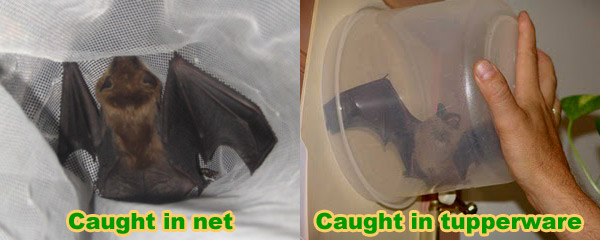- info@wildlifeanimalcontrol.com
Call us for help in your town
Wildlife Control Education
How to Catch a Bat in a House

Need bat removal in your hometown? We service over 500 USA locations! Click here to hire us in your town and check prices - updated for year 2020.
How to Catch a Bat - Bats are incredibly complex and interesting creatures. They thrive in the outdoors and live for the dark. This is why, if you find a bat in your house, chances are the bat is sick (with rabies or other harmful diseases) or unsuspectingly flew into your house to chase bugs. It might be afraid because it doesn’t know where it is and can be a danger to itself and humans. Catching a bat humanely is not difficult—it only takes a little bit of strategy and patience.
Before you try to catch a bat directly it is worth seeing if the
bat will leave on its own. Open the door to the room and keep the lights off. Go to the end of the room with a container that you can scratch, such as a yogurt container or milk jug. By scratching the container you are creating sound waves which will help the bat detect the outline of the door. When it realizes it has an exit, the bat will fly off on its own.
If this strategy doesn’t work—because the bat just doesn’t leave or it is in a room in the middle of the house—you can remove the bat yourself. Make sure to take necessary precautions to protect yourself before you try to catch and touch the bat. Wearing oven mitts or rubber or leather gloves will be sure to keep you from begin bitten and infected with rabies.
Using a fishing or butterfly net is one option—just make sure the holes in the net aren’t too big so the bat cannot squeeze out through a hole. This doesn’t always work well because of bats’ ability to detect small objects through sonar. The best net to use is a special bat net called a mist net which is made of really fine fibers and harder to detect. If the bat detects the swinging net, it will fly away and sit in a hard to reach place. If you manage to catch the bat, close the top of the net and bring it outside.
Other option is to wait for the bat to land on a sturdy surface and within reach. Snatching a bat out of mid air is tricky and will frighten the bat—making it defensive and aggressive. If the bat lands on a horizontal surface, such as the floor or a table,
throw a small towel, t-shirt or piece of fabric over the bat. This should keep the bat from flying and hiding again. Using a light piece of fabric will inhibit the bat from moving but will not harm the bat either. Scoop the bat up in the towel and keep the bat inside.
The bat will be frightened at this point and making clicking noises, but do not release it. Be sure to leave your gloves on as the bat will most likely try to bite through the towel or t-shirt. If you release it once it is afraid, it will be more difficult to capture it again because it will either be aggressive or hide in a hard-to-reach place.

If the bat lands on a banister or side wall and you cannot throw a towel over it, try to place a
coffee can or other container carefully over the bat. With gloves still on, slide the lid to the container between the bat and the wall—do not pinch any part of the bat.
Take the towel or the container outside a good distance from your house or apartment. Make sure you close your door behind you so the bat cannot fly back inside. Release the bat and back away slowly. Watch the bat’s behavior before going back inside. It will probably hop a few times and gather its bearing and then fly away.
If the bat is too tired from struggling in the towel or in the container or still too frightened to move, you may want to scoop it back up again with your gloved hands and place it on the bark of the tree. When handling the bat, be as gentle as possible and do not squeeze the bat. The bat will attach itself to the trunk and when it is ready the bat may climb back up into the tree and rest and take flight from there.
There is no reason to ever hurt or kill a bat to get it to exit your house. If you take a little time and a little planning, you can easily capture the bat and release it back into the wild.
More in-detail how-to bat removal articles:
Information about bat trapping - analysis and methods for how to trap.
Information about how to kill a bat - with fumigants or poison.
Information about how to keep bats away - prevention techniques.
Information about bat repellent - analysis of types and effectiveness.
You came here to learn how to catch a bat in your house. This site is intended to provide bat education and information, so that you can make an informed decision
if you need to deal with a bat problem in your attic or house. This site provides many bat control articles and strategies, if
you wish to attempt to solve the problem yourself. If you are unable to do so, which is likely with many
cases of bat removal, please go to the home page and click the USA map, where I have wildlife removal experts
listed in over 500 cites and towns, who can properly help you with your nuisance bat.
For more information,
go back to my main how to get rid of bats page.

















